Quoc Viet Hung Nguyen
A Multi-agent Text2SQL Framework using Small Language Models and Execution Feedback
Dec 21, 2025Abstract:Text2SQL, the task of generating SQL queries from natural language text, is a critical challenge in data engineering. Recently, Large Language Models (LLMs) have demonstrated superior performance for this task due to their advanced comprehension and generation capabilities. However, privacy and cost considerations prevent companies from using Text2SQL solutions based on external LLMs offered as a service. Rather, small LLMs (SLMs) that are openly available and can hosted in-house are adopted. These SLMs, in turn, lack the generalization capabilities of larger LLMs, which impairs their effectiveness for complex tasks such as Text2SQL. To address these limitations, we propose MATS, a novel Text2SQL framework designed specifically for SLMs. MATS uses a multi-agent mechanism that assigns specialized roles to auxiliary agents, reducing individual workloads and fostering interaction. A training scheme based on reinforcement learning aligns these agents using feedback obtained during execution, thereby maintaining competitive performance despite a limited LLM size. Evaluation results using on benchmark datasets show that MATS, deployed on a single- GPU server, yields accuracy that are on-par with large-scale LLMs when using significantly fewer parameters. Our source code and data are available at https://github.com/thanhdath/mats-sql.
Explainable and Fine-Grained Safeguarding of LLM Multi-Agent Systems via Bi-Level Graph Anomaly Detection
Dec 21, 2025Abstract:Large language model (LLM)-based multi-agent systems (MAS) have shown strong capabilities in solving complex tasks. As MAS become increasingly autonomous in various safety-critical tasks, detecting malicious agents has become a critical security concern. Although existing graph anomaly detection (GAD)-based defenses can identify anomalous agents, they mainly rely on coarse sentence-level information and overlook fine-grained lexical cues, leading to suboptimal performance. Moreover, the lack of interpretability in these methods limits their reliability and real-world applicability. To address these limitations, we propose XG-Guard, an explainable and fine-grained safeguarding framework for detecting malicious agents in MAS. To incorporate both coarse and fine-grained textual information for anomalous agent identification, we utilize a bi-level agent encoder to jointly model the sentence- and token-level representations of each agent. A theme-based anomaly detector further captures the evolving discussion focus in MAS dialogues, while a bi-level score fusion mechanism quantifies token-level contributions for explanation. Extensive experiments across diverse MAS topologies and attack scenarios demonstrate robust detection performance and strong interpretability of XG-Guard.
Scaling Text2SQL via LLM-efficient Schema Filtering with Functional Dependency Graph Rerankers
Dec 18, 2025Abstract:Most modern Text2SQL systems prompt large language models (LLMs) with entire schemas -- mostly column information -- alongside the user's question. While effective on small databases, this approach fails on real-world schemas that exceed LLM context limits, even for commercial models. The recent Spider 2.0 benchmark exemplifies this with hundreds of tables and tens of thousands of columns, where existing systems often break. Current mitigations either rely on costly multi-step prompting pipelines or filter columns by ranking them against user's question independently, ignoring inter-column structure. To scale existing systems, we introduce \toolname, an open-source, LLM-efficient schema filtering framework that compacts Text2SQL prompts by (i) ranking columns with a query-aware LLM encoder enriched with values and metadata, (ii) reranking inter-connected columns via a lightweight graph transformer over functional dependencies, and (iii) selecting a connectivity-preserving sub-schema with a Steiner-tree heuristic. Experiments on real datasets show that \toolname achieves near-perfect recall and higher precision than CodeS, SchemaExP, Qwen rerankers, and embedding retrievers, while maintaining sub-second median latency and scaling to schemas with 23,000+ columns. Our source code is available at https://github.com/thanhdath/grast-sql.
Learning Reconfigurable Representations for Multimodal Federated Learning with Missing Data
Oct 27, 2025



Abstract:Multimodal federated learning in real-world settings often encounters incomplete and heterogeneous data across clients. This results in misaligned local feature representations that limit the effectiveness of model aggregation. Unlike prior work that assumes either differing modality sets without missing input features or a shared modality set with missing features across clients, we consider a more general and realistic setting where each client observes a different subset of modalities and might also have missing input features within each modality. To address the resulting misalignment in learned representations, we propose a new federated learning framework featuring locally adaptive representations based on learnable client-side embedding controls that encode each client's data-missing patterns. These embeddings serve as reconfiguration signals that align the globally aggregated representation with each client's local context, enabling more effective use of shared information. Furthermore, the embedding controls can be algorithmically aggregated across clients with similar data-missing patterns to enhance the robustness of reconfiguration signals in adapting the global representation. Empirical results on multiple federated multimodal benchmarks with diverse data-missing patterns across clients demonstrate the efficacy of the proposed method, achieving up to 36.45\% performance improvement under severe data incompleteness. The method is also supported by a theoretical analysis with an explicit performance bound that matches our empirical observations. Our source codes are provided at https://github.com/nmduonggg/PEPSY
TableDART: Dynamic Adaptive Multi-Modal Routing for Table Understanding
Sep 18, 2025Abstract:Modeling semantic and structural information from tabular data remains a core challenge for effective table understanding. Existing Table-as-Text approaches flatten tables for large language models (LLMs), but lose crucial structural cues, while Table-as-Image methods preserve structure yet struggle with fine-grained semantics. Recent Table-as-Multimodality strategies attempt to combine textual and visual views, but they (1) statically process both modalities for every query-table pair within a large multimodal LLMs (MLLMs), inevitably introducing redundancy and even conflicts, and (2) depend on costly fine-tuning of MLLMs. In light of this, we propose TableDART, a training-efficient framework that integrates multimodal views by reusing pretrained single-modality models. TableDART introduces a lightweight 2.59M-parameter MLP gating network that dynamically selects the optimal path (either Text-only, Image-only, or Fusion) for each table-query pair, effectively reducing redundancy and conflicts from both modalities. In addition, we propose a novel agent to mediate cross-modal knowledge integration by analyzing outputs from text- and image-based models, either selecting the best result or synthesizing a new answer through reasoning. This design avoids the prohibitive costs of full MLLM fine-tuning. Extensive experiments on seven benchmarks show that TableDART establishes new state-of-the-art performance among open-source models, surpassing the strongest baseline by an average of 4.02%. The code is available at: https://anonymous.4open.science/r/TableDART-C52B
Task Allocation for Autonomous Machines using Computational Intelligence and Deep Reinforcement Learning
Aug 28, 2025Abstract:Enabling multiple autonomous machines to perform reliably requires the development of efficient cooperative control algorithms. This paper presents a survey of algorithms that have been developed for controlling and coordinating autonomous machines in complex environments. We especially focus on task allocation methods using computational intelligence (CI) and deep reinforcement learning (RL). The advantages and disadvantages of the surveyed methods are analysed thoroughly. We also propose and discuss in detail various future research directions that shed light on how to improve existing algorithms or create new methods to enhance the employability and performance of autonomous machines in real-world applications. The findings indicate that CI and deep RL methods provide viable approaches to addressing complex task allocation problems in dynamic and uncertain environments. The recent development of deep RL has greatly contributed to the literature on controlling and coordinating autonomous machines, and it has become a growing trend in this area. It is envisaged that this paper will provide researchers and engineers with a comprehensive overview of progress in machine learning research related to autonomous machines. It also highlights underexplored areas, identifies emerging methodologies, and suggests new avenues for exploration in future research within this domain.
Model-Free Counterfactual Subset Selection at Scale
Feb 12, 2025Abstract:Ensuring transparency in AI decision-making requires interpretable explanations, particularly at the instance level. Counterfactual explanations are a powerful tool for this purpose, but existing techniques frequently depend on synthetic examples, introducing biases from unrealistic assumptions, flawed models, or skewed data. Many methods also assume full dataset availability, an impractical constraint in real-time environments where data flows continuously. In contrast, streaming explanations offer adaptive, real-time insights without requiring persistent storage of the entire dataset. This work introduces a scalable, model-free approach to selecting diverse and relevant counterfactual examples directly from observed data. Our algorithm operates efficiently in streaming settings, maintaining $O(\log k)$ update complexity per item while ensuring high-quality counterfactual selection. Empirical evaluations on both real-world and synthetic datasets demonstrate superior performance over baseline methods, with robust behavior even under adversarial conditions.
Tackling Data Heterogeneity in Federated Time Series Forecasting
Nov 24, 2024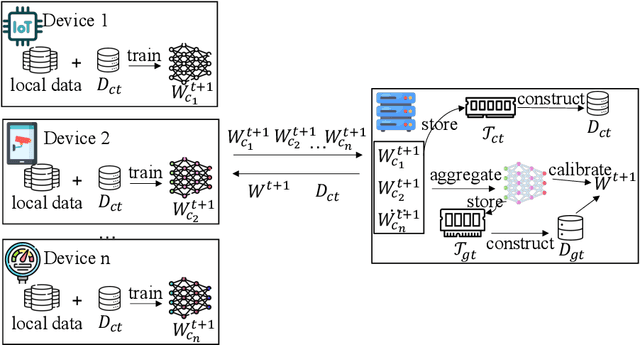

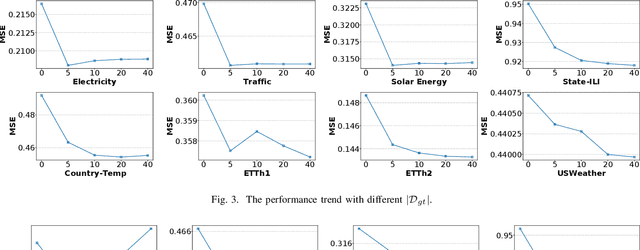

Abstract:Time series forecasting plays a critical role in various real-world applications, including energy consumption prediction, disease transmission monitoring, and weather forecasting. Although substantial progress has been made in time series forecasting, most existing methods rely on a centralized training paradigm, where large amounts of data are collected from distributed devices (e.g., sensors, wearables) to a central cloud server. However, this paradigm has overloaded communication networks and raised privacy concerns. Federated learning, a popular privacy-preserving technique, enables collaborative model training across distributed data sources. However, directly applying federated learning to time series forecasting often yields suboptimal results, as time series data generated by different devices are inherently heterogeneous. In this paper, we propose a novel framework, Fed-TREND, to address data heterogeneity by generating informative synthetic data as auxiliary knowledge carriers. Specifically, Fed-TREND generates two types of synthetic data. The first type of synthetic data captures the representative distribution information from clients' uploaded model updates and enhances clients' local training consensus. The second kind of synthetic data extracts long-term influence insights from global model update trajectories and is used to refine the global model after aggregation. Fed-TREND is compatible with most time series forecasting models and can be seamlessly integrated into existing federated learning frameworks to improve prediction performance. Extensive experiments on eight datasets, using several federated learning baselines and four popular time series forecasting models, demonstrate the effectiveness and generalizability of Fed-TREND.
On-device Content-based Recommendation with Single-shot Embedding Pruning: A Cooperative Game Perspective
Nov 20, 2024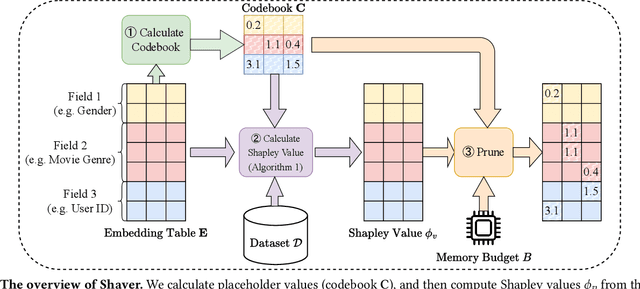

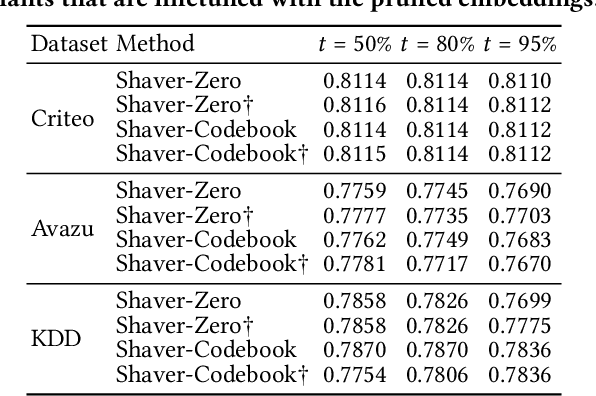
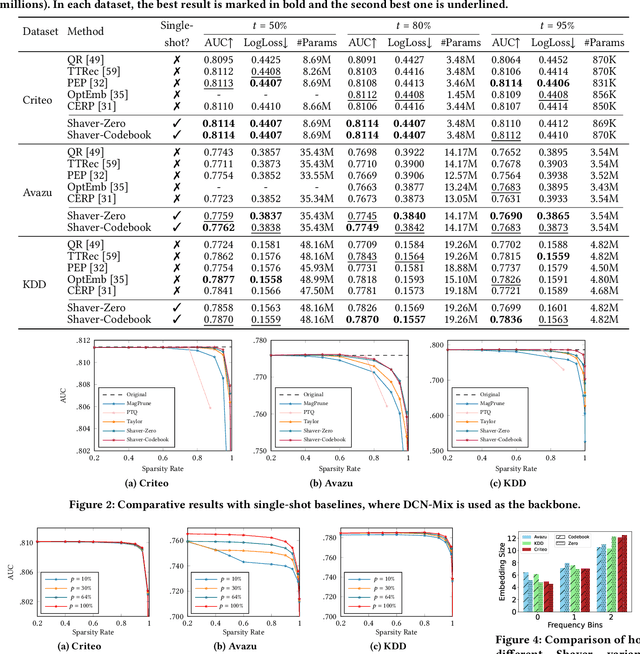
Abstract:Content-based Recommender Systems (CRSs) play a crucial role in shaping user experiences in e-commerce, online advertising, and personalized recommendations. However, due to the vast amount of categorical features, the embedding tables used in CRS models pose a significant storage bottleneck for real-world deployment, especially on resource-constrained devices. To address this problem, various embedding pruning methods have been proposed, but most existing ones require expensive retraining steps for each target parameter budget, leading to enormous computation costs. In reality, this computation cost is a major hurdle in real-world applications with diverse storage requirements, such as federated learning and streaming settings. In this paper, we propose Shapley Value-guided Embedding Reduction (Shaver) as our response. With Shaver, we view the problem from a cooperative game perspective, and quantify each embedding parameter's contribution with Shapley values to facilitate contribution-based parameter pruning. To address the inherently high computation costs of Shapley values, we propose an efficient and unbiased method to estimate Shapley values of a CRS's embedding parameters. Moreover, in the pruning stage, we put forward a field-aware codebook to mitigate the information loss in the traditional zero-out treatment. Through extensive experiments on three real-world datasets, Shaver has demonstrated competitive performance with lightweight recommendation models across various parameter budgets. The source code is available at https://anonymous.4open.science/r/shaver-E808
Scalable and Effective Negative Sample Generation for Hyperedge Prediction
Nov 19, 2024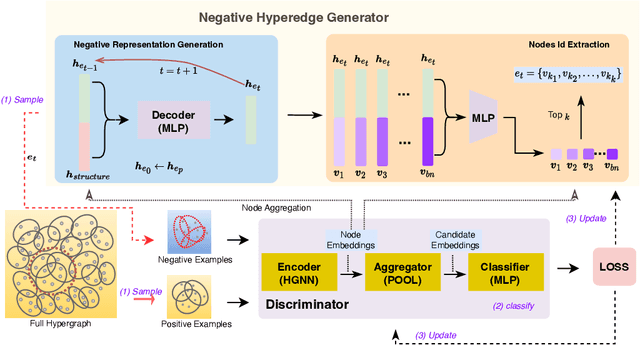
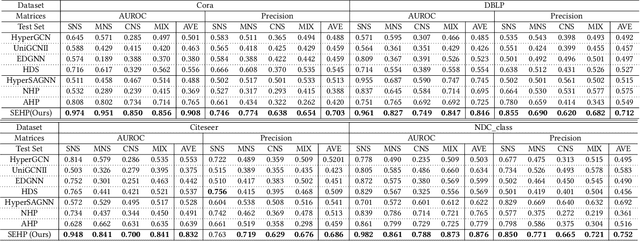
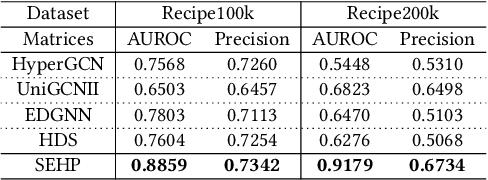
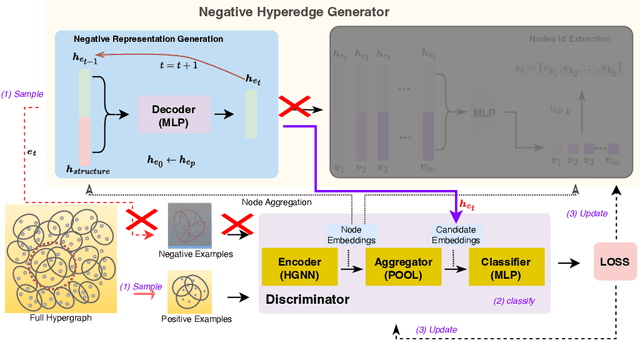
Abstract:Hyperedge prediction is crucial in hypergraph analysis for understanding complex multi-entity interactions in various web-based applications, including social networks and e-commerce systems. Traditional methods often face difficulties in generating high-quality negative samples due to the imbalance between positive and negative instances. To address this, we present the Scalable and Effective Negative Sample Generation for Hyperedge Prediction (SEHP) framework, which utilizes diffusion models to tackle these challenges. SEHP employs a boundary-aware loss function that iteratively refines negative samples, moving them closer to decision boundaries to improve classification performance. SEHP samples positive instances to form sub-hypergraphs for scalable batch processing. By using structural information from sub-hypergraphs as conditions within the diffusion process, SEHP effectively captures global patterns. To enhance efficiency, our approach operates directly in latent space, avoiding the need for discrete ID generation and resulting in significant speed improvements while preserving accuracy. Extensive experiments show that SEHP outperforms existing methods in accuracy, efficiency, and scalability, representing a substantial advancement in hyperedge prediction techniques. Our code is available here.
 Add to Chrome
Add to Chrome Add to Firefox
Add to Firefox Add to Edge
Add to Edge